Smith&Steward
Amateur
Okay I've had some trouble figuring out which topics to present in which order. So I'll start with the most long term and seasonally appropriate for late March 2024, which should be pretty close to a frost free date for most regions in the United States. Let me say that I am not an expert. The information here comes from my own personal experience along with what I have learned from others as well as books. Hopefully you will find what works for you and
First thing first, figuring out what growing region you are in. This determines what is native to your area, what will grow in your soil and how long your natural growing season will be. Second and this is super important, contact "JULIE" or whatever your regional free underground locating service is called. Do yourself a big favor and make sure where all of the utilities and underground whatever's are before you cut into them with a shovel or bucket blade. Also think about if a utility company has to dig to do replacements or repairs will your work be affected or destroyed entirely.
After that you can find an area that has the best sunlight with little or no branches/limbs from bigger trees overhead. Think about when those surrounding trees are in full bloom and when they are bare. When bare and dormant the branches will have a greater chance of falling and possibly crushing the younger saplings. When in bloom the foliage can block light and inhibit growth. Placement of fruiting trees can accent or anchor the rest of your design plans. Using perma-culture techniques like guilding we can bring together beneficial plants to help the trees thrive, certain herbs will repel certain incest and critters, attract predatory insects or pollinators and some even put nutrients back into the soil as they grow. Building a separate pollinator garden the fills the space between the trees will ensure that the flowers on the trees will be pollinated and produce fruit. Not spraying your lawn for dandelions and other broadleaves will allow native perennials to grow and spread. Bringing in other batches of possibly edible or medicinal plants that require no effort on your part. Here's a riddle; does honey taste like dandelion or do dandelions taste like honey?
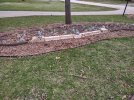
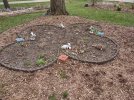
Choosing varieties that will work for you could be different from what I chose to do based on region and soil type. Some varieties and species need to be cross-pollinated( pollen is used from two different varieties inside the same species) others do not. Some varieties need full sun while others will like part sun. Do the homework and research before choosing trees at the garden supply. This will save money and time. Spacing can always be controlled by trimming and pruning. The trees do not have to get very large in order to produce lots of fruit, they need to be mature and healthy. Getting saplings to their mature state will take time, 3-5 years depending on conditions and effort, protecting, feeing and pruning. But it is all worth it once you pull your first fruits off. For me it was last season, 5 pears and two apples from a total of four mature trees. We have 5 more that were girdled by squirrels, hopefully they will survive.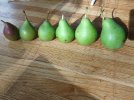
That leads in nicely to protection. Again this depends largely on individual region as every place will have different concerns with different critters or insects. For me it's squirrels and white tail deer that will cause the most damage. And it will not take an entire season either, most likely you will wake up one morning to see the horrific damage. That's what happened to me three times each time a different offender and problem. From deer to squirrel to incest infestation. Building cages with cattle panel is a good option for deer, but may not deter squirrels. Netting can be draped over PVC pipe surrounding the tree. Little plastic collars or tubes, like pool noodles, can be placed around the truck to prevent girdling from squirrels. For some reason the PVC pipe surrounding the tree even without the netting seems to be effective at steering the deer as well as the squirrels away. I don't know why but that tree is now mature enough to bare fruit this year if the weather cooperates. The cattle panel cages are likely the best bet for being able to cover and insulate the tree if the temperatures drop while the tree in in the flowering stage. If the flowers freeze and die there will be no fruit. That does however mean that the tree will put all of its energy into growing stronger that season. So not a total loss there.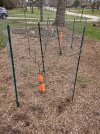
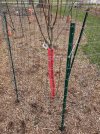
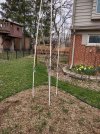
Now if you don't have good workable soil where you are, like I do in the Midwest, building a box frame or getting extra large felt bags may be a better option. Making soil with techniques like a "hugelkultur" mound or "no-dig" bed made from wetting down layers of compost, untreated wood or cardboard, and other yard waste could be used to build up and actually create nutrient rich living soil over time, about three years or so. These are long term sustainable options for those looking to increase self sufficiency and those looking to reconnect with the growth cycles of nature alike. The benefits go beyond plucking a few pieces of fruit every year.
I hope you all find this little primer helpful. Again I am by no means an expert in this or anything else. I try, I fail, I learn. What worked for me may or may not work for you. What worked for some person on social media may turn out to be entirely false. It's best to do your own research and try things out for yourself to determine for sure what will work and what will not. This stuff takes time and there will be an individual learning curve for everyone.
First thing first, figuring out what growing region you are in. This determines what is native to your area, what will grow in your soil and how long your natural growing season will be. Second and this is super important, contact "JULIE" or whatever your regional free underground locating service is called. Do yourself a big favor and make sure where all of the utilities and underground whatever's are before you cut into them with a shovel or bucket blade. Also think about if a utility company has to dig to do replacements or repairs will your work be affected or destroyed entirely.
After that you can find an area that has the best sunlight with little or no branches/limbs from bigger trees overhead. Think about when those surrounding trees are in full bloom and when they are bare. When bare and dormant the branches will have a greater chance of falling and possibly crushing the younger saplings. When in bloom the foliage can block light and inhibit growth. Placement of fruiting trees can accent or anchor the rest of your design plans. Using perma-culture techniques like guilding we can bring together beneficial plants to help the trees thrive, certain herbs will repel certain incest and critters, attract predatory insects or pollinators and some even put nutrients back into the soil as they grow. Building a separate pollinator garden the fills the space between the trees will ensure that the flowers on the trees will be pollinated and produce fruit. Not spraying your lawn for dandelions and other broadleaves will allow native perennials to grow and spread. Bringing in other batches of possibly edible or medicinal plants that require no effort on your part. Here's a riddle; does honey taste like dandelion or do dandelions taste like honey?


Choosing varieties that will work for you could be different from what I chose to do based on region and soil type. Some varieties and species need to be cross-pollinated( pollen is used from two different varieties inside the same species) others do not. Some varieties need full sun while others will like part sun. Do the homework and research before choosing trees at the garden supply. This will save money and time. Spacing can always be controlled by trimming and pruning. The trees do not have to get very large in order to produce lots of fruit, they need to be mature and healthy. Getting saplings to their mature state will take time, 3-5 years depending on conditions and effort, protecting, feeing and pruning. But it is all worth it once you pull your first fruits off. For me it was last season, 5 pears and two apples from a total of four mature trees. We have 5 more that were girdled by squirrels, hopefully they will survive.

That leads in nicely to protection. Again this depends largely on individual region as every place will have different concerns with different critters or insects. For me it's squirrels and white tail deer that will cause the most damage. And it will not take an entire season either, most likely you will wake up one morning to see the horrific damage. That's what happened to me three times each time a different offender and problem. From deer to squirrel to incest infestation. Building cages with cattle panel is a good option for deer, but may not deter squirrels. Netting can be draped over PVC pipe surrounding the tree. Little plastic collars or tubes, like pool noodles, can be placed around the truck to prevent girdling from squirrels. For some reason the PVC pipe surrounding the tree even without the netting seems to be effective at steering the deer as well as the squirrels away. I don't know why but that tree is now mature enough to bare fruit this year if the weather cooperates. The cattle panel cages are likely the best bet for being able to cover and insulate the tree if the temperatures drop while the tree in in the flowering stage. If the flowers freeze and die there will be no fruit. That does however mean that the tree will put all of its energy into growing stronger that season. So not a total loss there.



Now if you don't have good workable soil where you are, like I do in the Midwest, building a box frame or getting extra large felt bags may be a better option. Making soil with techniques like a "hugelkultur" mound or "no-dig" bed made from wetting down layers of compost, untreated wood or cardboard, and other yard waste could be used to build up and actually create nutrient rich living soil over time, about three years or so. These are long term sustainable options for those looking to increase self sufficiency and those looking to reconnect with the growth cycles of nature alike. The benefits go beyond plucking a few pieces of fruit every year.
I hope you all find this little primer helpful. Again I am by no means an expert in this or anything else. I try, I fail, I learn. What worked for me may or may not work for you. What worked for some person on social media may turn out to be entirely false. It's best to do your own research and try things out for yourself to determine for sure what will work and what will not. This stuff takes time and there will be an individual learning curve for everyone.









